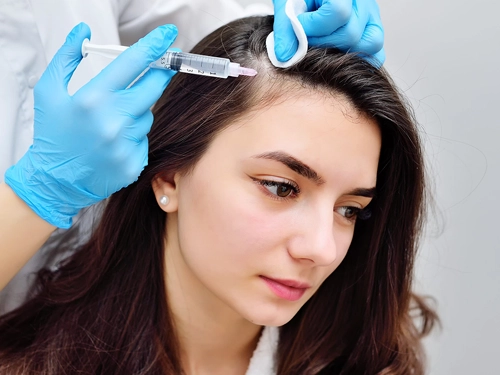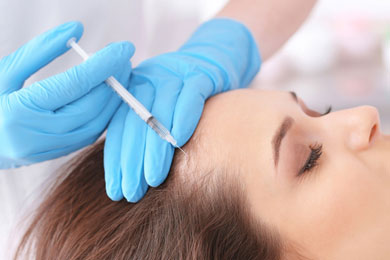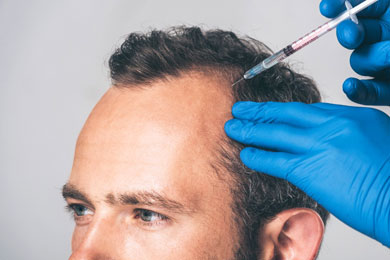
Hair loss, an oppressive condition that affects millions of people worldwide, frequently induces profound emotional anguish. Although conventional treatments have demonstrated a range of outcomes, exosome therapy has emerged as an innovative and potentially more efficacious alternative.
Prevalence and Psychological Consequences
Alopecia, the medical term for hair loss, is a condition that impacts a considerable proportion of the populace. It is a psychological condition in addition to a medical one, frequently resulting in diminished self-esteem and social anxiety.
A Cellular Breakthrough
Exosomes, which were previously overlooked as mere cellular debris, are now acknowledged for their function in intercellular communication. They transport RNA, proteins, and lipids, thereby facilitating a multitude of biological processes.
The Significance of Regenerative Medicine
Particularly intriguing in the field of regenerative medicine are exosomes derived from stem cells. Their capacity to stimulate regeneration and tissue repair has placed them at the vanguard of research concerning the treatment of numerous conditions, including hair loss.
The Innovative Mechanism
Exosome therapy for hair loss entails the direct application to the scalp of solutions high in exosomes. Loaded with growth factors and proteins, these exosomes revitalize hair follicles, thereby preventing further hair loss and stimulating hair growth.
A non-invasive methodology: In contrast to hair transplant surgery, exosome therapy provides a minimally invasive alternative by not necessitating incisions.
Natural Hair Regrowth: It stimulates the natural hair regrowth mechanisms of the body.
Safety and Tolerability: in general, demonstrates a diminished propensity for adverse reactions in comparison to more traditional remedies for hair loss.
Exosome treatment for hair loss is an advanced medical procedure that should be performed by trained healthcare professionals. The process generally involves several key steps, which I will outline below. However, it's important to note that specifics can vary based on the protocol of the particular clinic or medical professional conducting the treatment.
Objective: Assess the patient's suitability for exosome treatment.
Activities: Discuss medical history, examine the scalp, and set realistic expectations about the treatment's outcome.
Objective: Prepare the patient and the treatment area.
Activities: The scalp may be cleaned, and a local anesthetic may be applied to minimize discomfort.
Objective: Prepare the exosome-rich solution.
Activities: This involves procuring a concentration of exosomes, often derived from stem cells. The exosomes are suspended in a solution suitable for injection.
Objective: Administer the exosome solution into the scalp.
Activities: Using a fine needle, the healthcare provider injects the exosome solution into areas of the scalp affected by hair loss. The process is usually minimally invasive and may take from a few minutes to an hour, depending on the area being treated.
Objective: Ensure proper scalp care following the procedure.
Activities: Patients are typically advised to avoid washing their hair or engaging in strenuous activities for a certain period after the treatment. Specific instructions may vary.
Objective: Assess the effectiveness of the treatment and plan any subsequent sessions.
Activities: Follow-up appointments are scheduled to monitor hair growth and scalp health. Additional treatments may be recommended based on the initial response.
Emerging research and anecdotal evidence indicate that hair regrowth and thickness may improve. Sustained investigation is essential for validating these results and comprehending the enduring ramifications of exosome therapy.
Treatment of hair loss with exosomes represents an innovative and promising frontier in the fight against alopecia. By integrating cutting-edge scientific advancements with an emphasis on natural processes and safety, it presents a renewed prospect for individuals in search of alternatives to conventional remedies for hair loss.
By extensively examining each subject matter, this expanded edition guarantees comprehensive coverage of exosome therapy as it relates to hair loss. By providing an exhaustive analysis of multiple facets of the subject, the article's worth and SEO potential are enhanced through the inclusion of supplementary information.
Exosome therapy is a therapeutic approach that utilizes exosomes, which are extracellular vesicles originating from stem cells. It is postulated that these exosomes transport materials and signals that facilitate cellular repair and regeneration; particularly in relation to hair loss, they may restore hair follicles.
By transporting growth factors, proteins, and genetic material that promote hair follicle health, exosomes may facilitate hair regrowth. Potentially reversible is the miniaturization of hair follicles, a significant contributor to numerous forms of hair loss.
Although promising preliminary research and anecdotal support exist, exosome therapy is still regarded as an experimental approach. Strict scientific evaluations are necessary to definitively establish the efficacy and safety of the treatment for hair loss.
Exosomes are vesicles on the nanoscale that are secreted by virtually every cell type. They are essential for cellular communication as they transport proteins, lipids, and RNA to other cells; their function may even affect the behavior of hair follicles.
The procedure entails the direct injection of a concentrated exosome solution into the cranium. This procedure necessitates expertise and precision and is typically performed in a clinical setting.
Mild side effects are frequently encountered and may manifest at the site of injection as transient discomfort, edema, or erythema. The risk of more severe adverse effects is being investigated at this time.
Certain patients may observe enhancements in the density and texture of their hair within a few weeks following treatment. However, the complete appreciation of the results may require several months.
As of the most recent information, exosome therapy is not FDA-approved and is considered an off-label use, specifically for the treatment of hair loss.
While exosome therapy has demonstrated potential in promoting hair regrowth in areas of thinning hair, its efficacy in completely hairless regions remains uncertain and further investigation is warranted.
While it might exhibit efficacy in treating hair loss induced by environmental factors or aging, its effectiveness is comparatively diminished when applied to genetic conditions such as male or female pattern baldness.
Certain patients may observe improvement after a single session, whereas others may require a sequence of sessions separated by several months.
Costs vary considerably and are typically quite high, contingent upon factors such as clinic, geographic location, and the extent of treatment needed.
It is possible to combine it with other treatments such as finasteride, platelet-rich plasma (PRP),or minoxidil; however, such combinations should be supervised by a healthcare professional.
The exact quantification of success rates is challenging to achieve as a result of the experimental design of the therapy. The response of patients may vary depending on specific individual factors and the root cause of their hair loss.
Unknown is the exact duration of the effects, which may not be permanent. Possible requirements include ongoing maintenance and subsequent treatments.
Individuals who are undergoing hair reduction or loss for reasons other than genetic baldness are considered ideal candidates. A comprehensive assessment conducted by a healthcare professional is imperative in order to ascertain appropriateness.
No evidence exists to support the claim that exosome therapy causes hair loss directly. While its intended effect is to stimulate hair growth, individual responses may differ.
In contrast to platelet-rich plasma (PRP),which extracts growth factors from a patient's own blood, exosome therapy is thought to deliver a potentially more potent and concentrated dose of growth-promoting substances. However, the efficacy of PRP in treating hair loss is supported by more established research and a lengthier track record.
Understanding the interaction between exosomes and hair follicles, their safety profile, and the most effective method of harvesting and administering them for hair loss treatment is the focus of current research.
Exosomes are commonly obtained from mesenchymal stem cells, which are renowned for their ability to promote regeneration. To determine the most effective source of exosomes for hair regrowth, ongoing research is being conducted.
While research is being conducted on the potential of exosome therapy to treat hair loss in both males and women, individual responses may differ depending on the underlying cause of the condition.
The recovery period is typically brief, allowing the majority of patients to promptly resume their regular activities following the procedure.
In contrast to hair transplant surgery, which entails the physical transfer of hair follicles from one region of the cranium to another, exosome therapy is a non-surgical approach that seeks to promote the growth of pre-existing hair follicles.
Can exosome therapy be used to prevent hair loss?
Further investigation is required to ascertain the efficacy of exosome therapy as a preventative treatment, despite the interest that has been generated in its application.
How do patients typically respond to exosome therapy for hair loss?
Diverse opinions exist regarding the extent of improvements observed in hair density and thickness; certain patients have reported substantial enhancements, whereas others may perceive only slight or negligible alterations.
Is there a best age for undergoing exosome therapy for hair loss?
Although there is no universally recognized "optimal age" for the therapy, individuals with partially quiescent hair follicles may experience greater efficacy.
Can lifestyle factors affect the results of exosome therapy?
Diet, stress, and general health are all variables that can impact the efficacy of hair loss treatments, including exosome therapy.
Are there any contraindications for exosome therapy in hair loss?
Candidates may not be appropriate for individuals who have specific medical conditions, immune system disorders, or are currently taking particular medications. A medical examination is required in order to determine eligibility.
How is the quality of exosomes ensured for hair loss therapy?
Quality control entails the verification of exosomes' concentration and purity, frequently by means of stringent laboratory procedures and established criteria.
What kind of follow-up is required after exosome therapy for hair loss?
Typical follow-up consists of monitoring hair growth and scalp health, with potential additions of remedies contingent upon an individual's response.
Can exosome therapy be used in combination with hair transplant surgery?
Further investigation is warranted, but there is some speculation that exosome therapy may improve the outcomes of hair transplants.
Is exosome therapy covered by insurance for hair loss treatment?
As a treatment for hair loss, exosome therapy is generally not covered by insurance due to its experimental nature.
How does exosome therapy impact the natural hair growth cycle?
There is a belief that the therapy has a beneficial impact on the hair growth cycle, possibly delaying the anagen (growth) phase and reinvigorating latent follicles.
Are there any long-term studies on exosome therapy for hair loss?
Further research is required to ascertain the long-term implications, safety profile, and durability of the outcomes associated with exosome therapy.
Can exosome therapy treat hair loss caused by chemotherapy?
Despite the interest in this topic, additional research is necessary to ascertain its efficacy in treating chemotherapy-induced hair loss.
What should patients expect during an exosome therapy session for hair loss?
Patients can anticipate a sequence of scalp injections, some of which may induce discomfort. Generally, the procedure lasts approximately one hour.
How does exosome therapy compare to over-the-counter hair loss treatments?
Exosome therapy is regarded as a potentially more effective and sophisticated alternative to over-the-counter remedies; however, it is more costly and less readily available.
Can exosome therapy address hair thinning as well as bald patches?
While it exhibits potential in the treatment of hair thinning and potentially provides some relief for smaller bald regions, its efficacy in managing larger bald areas remains uncertain.
What are the potential risks of exosome therapy for hair loss?
Infection, allergic reactions, and unidentified long-term consequences are all potential hazards associated with exosome introduction.
Is exosome therapy for hair loss available worldwide?
Regional and national variations exist in terms of availability, with specialized clinics and research institutions housing it more frequently.
Hello, Are you doing exosome treatment for hair loss in your clinic ? If yes, please describe how many treatments are usually needed and how often for good results, whether I can visit the doctor and in the same day make a treatment, and what is the price. Thank you
Thank you for reaching out to us regarding exosome treatment for hair loss. Availability of Exosome Treatment: We are pleased to inform you that our clinic offers exosome therapy as a cutting-edge solution for hair loss. This innovative treatment utilizes exosomes—small extracellular vesicles rich in growth factors—to stimulate hair follicles and promote hair growth. Treatment Protocol: The number of treatments required can vary based on individual factors, including the extent of hair loss and your specific response to therapy. Typically, patients undergo a series of sessions spaced several weeks apart to achieve optimal results. During your initial consultation, we will assess your condition and develop a personalized treatment plan tailored to your needs. Same-Day Consultation and Treatment: We understand the importance of convenience for our patients. In many cases, it is possible to have a consultation and proceed with the first treatment session on the same day. However, this depends on individual circumstances and scheduling availability. We recommend contacting us in advance to arrange an appointment and discuss the feasibility of same-day treatment. Pricing Information: The cost of exosome therapy varies depending on the number of sessions required and the specific treatment plan designed for you. To provide accurate pricing, we encourage you to contact our clinic directly. Our team will be happy to discuss the details and answer any questions you may have. Please let us know if you would like to schedule a consultation or if you have further inquiries. We are here to assist you and look forward to helping you achieve your hair restoration goals. Warm regards,
 Advances in Stem Cell-Based Therapy for Hair Loss
Advances in Stem Cell-Based Therapy for Hair LossHair loss is a common problem that affects millions of people worldwide. While there are various treatments available for hair loss, such as medication, hair transplant surgery, and topical treatments, they Read More...
 How Much Do Adipose Derived Stem Cells Cost?
How Much Do Adipose Derived Stem Cells Cost?According to a report by the International Society of Hair Restoration Surgery, the cost of stem cell therapy for hair loss can range from $3,000 to $10,000 per session, with multiple sessions required for o Read More...
 Does Stem Cell Therapy Work on Hair Loss?
Does Stem Cell Therapy Work on Hair Loss?Loss of hair is a widespread problem that affects millions of individuals globally. There are numerous therapies available for hair loss, but not all of them may be beneficial for every individual. Read More...